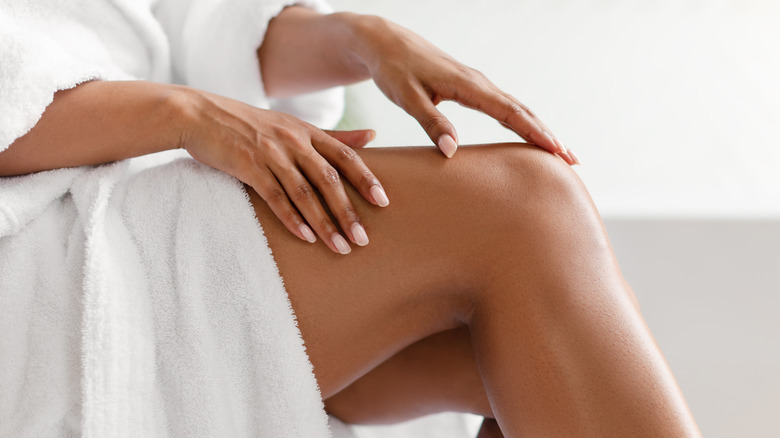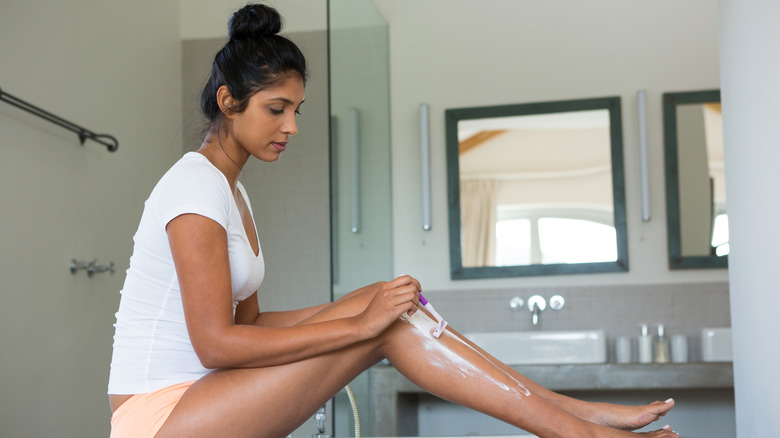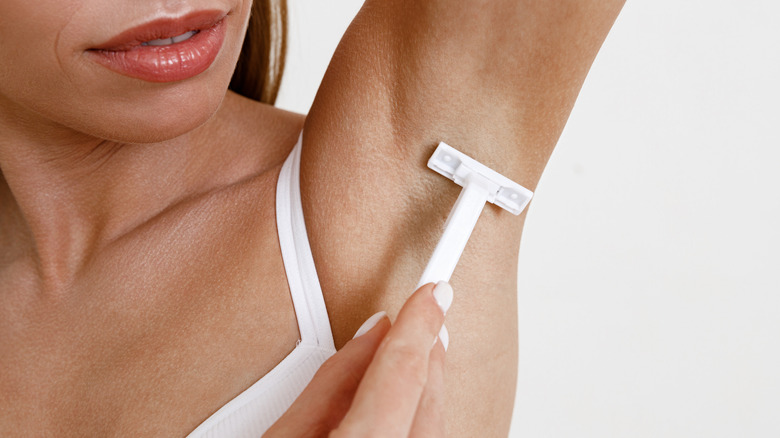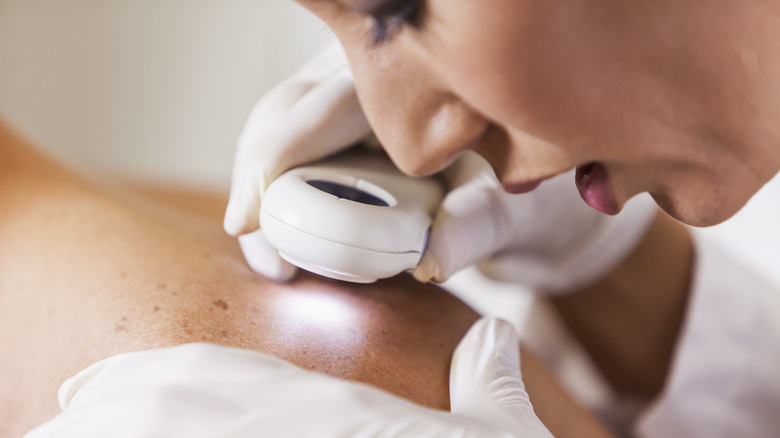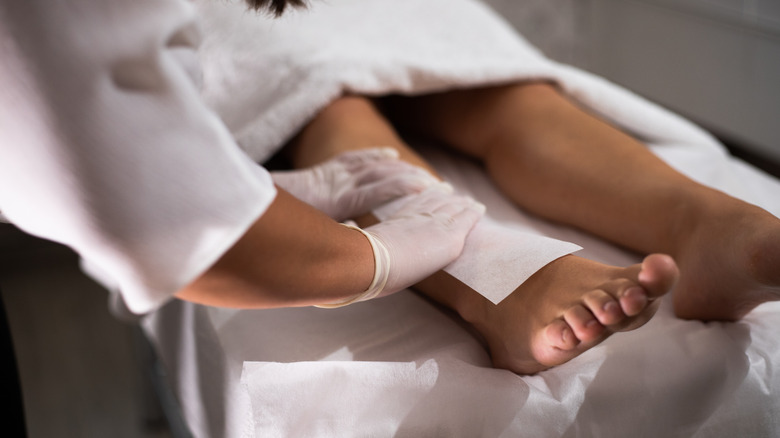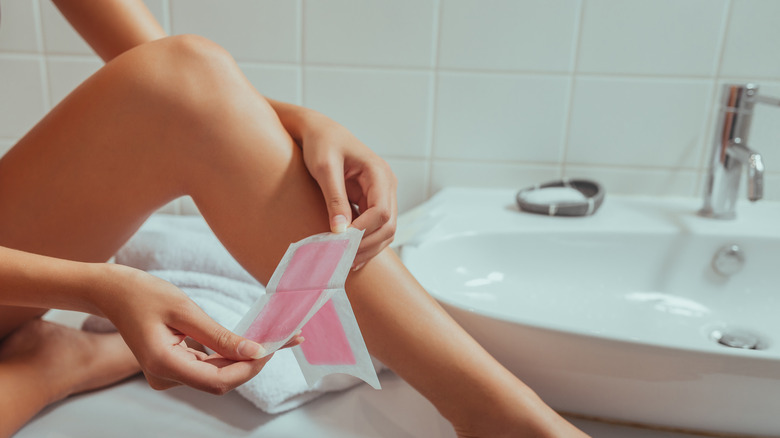Waxing Vs. Shaving: Which Is Better For You?
If you're conscious of your body hair and on board with removing it, you likely already know there are several ways to do so. Waxing and shaving are among the most common, with many people turning to these methods to quickly and effectively eliminate their body hair. They're also some of the more affordable hair removal techniques, even for those who choose to skip the aesthetician for a waxing. However, waxing and shaving may be best reserved for specific areas of the body, especially for people who have sensitive skin. For example, some prefer to have waxing done in areas that are more prone to razor burn. "The private areas and skin folds — armpits, bikini, buttock — are best for waxing," dermatologist Dr. Karen Lal told Marie Claire.
That being said, it's not uncommon for people to fear shifting from shaving to waxing, given the stereotypical recreations often shown in television shows and movies — who can forget the image of a person screaming while having a waxing strip removed? Understanding which hair removal process is best for your specific skin and areas of your body can help you make more informed decisions.
Shaving: the benefits and best areas for it on your body
Shaving is one of the simplest ways to remove hair — all you need is a razor (and shaving cream, if you want to properly prep your skin), and you're ready to go. Additionally, it's one of the more economical hair removal methods, especially if you need to tackle large areas of your body. This is undoubtedly one of the reasons why many people turn to their razors to remove hair from their legs and arms, for instance.
Regardless of its formulation, shaving cream can be your best friend if you prefer to use your razor. Once you wet your skin, all you need to do is layer a thin coat of shaving cream across the area you're targeting before gliding your razor over it. After the hair is removed, you can rinse away any excess shaving cream with water and soothe your skin with a moisturizer.
Shaving works for practically any part of the body, but there are caveats — working with a sharp blade on the end of a handle isn't ideal for precision. This may make shaving perfect for your legs, for example, but difficult to execute around your bikini line.
How to refine your shaving technique and minimize risks
Your shaving technique plays a larger role in the results — as well as the side effects — you see from this form of hair removal. L'Oreal notes that dry shaving is never advised by experts, as it can dramatically increase your risk of skin irritation and cuts. In addition to using shaving cream and wetting your skin before reaching for your razor, you might also benefit from timing your hair removal. For example, waiting until the end of your bath or shower (instead of doing it as soon as you hop in) can ensure that your skin is as soft as possible.
Some of the obvious side effects of shaving for hair removal are nicks, cuts, skin irritation (itching), and razor burn. However, ingrown hairs and folliculitis — a common fungal or bacterial skin infection — are also risks. The sensitivity of your skin, as well as the sharpness of your razor, will ultimately play roles in the side effects that you experience.
Shaving frequency and underlying skin conditions
Perhaps the most obvious downside to shaving as a form of hair removal is its longevity — or rather, the lack thereof. Depending on how quickly your hair grows back, you might notice regrowth within just a couple of days. That being said, it's not necessary to shave every day. Keep in mind that razors remove a layer of skin cells when you shave, and skipping a couple of sessions can allow your skin to heal. This may be especially beneficial if you notice that your skin is sensitive or more prone to cuts during hair removal.
If you have underlying skin conditions, such as acne, the American Academy of Dermatology Association (AAD) states that it's best to avoid shaving around breakouts — doing so can make your acne worse. Always reach out to your dermatologist if you're concerned about how shaving may be impacting your skin, especially if you have a pre-existing skin condition.
Waxing: why this method can be worth the pain
Waxing is a go-to method of hair removal for those who want more than just a few days of silky smooth skin. While shaving may quick and affordable, waxing can give you weeks of hairlessness. Best of all, it can be done on almost any part of the body, making it a preferred hair removal method if you've been hesitant to use a razor in sensitive areas.
If you're new to waxing, it's important to note that your hair ideally needs to be at least one-fourth of an inch in length. This is because short hair is not as easy to grasp and remove — a bit longer is always better when it comes to waxing. Regardless of your pain tolerance, it's also a good idea to prepare for soreness before this hair removal method. Taking an over-the-counter pain reliever can help minimize any pain that comes after waxing, but always talk to your doctor if you have any specific concerns.
The risks associated with waxing
Whether you choose to wax at home or make an appointment with an aesthetician, it's worth weighing the risks before trying this hair removal method. Aside from the soreness that can develop after the waxing, the hot wax itself can result in accidental burns if you're trying this method at home. Similar to shaving, there are also common side effects that may arise after waxing. In addition to the pain of the hair removal, you might experience ingrown hairs, skin irritation, and redness.
There are also several underlying conditions that need to be considered before you wax, and they don't just pertain to the skin. Those with diabetes, for example, or people who take certain medications (blood thinners or hormonal birth control, for instance) will want to speak to their doctor first, according to Healthline. If you use anti-aging skincare products or certain acne treatments, you'll also need to talk to your dermatologist to get a better idea of the risks before undergoing a waxing.
Tips for waxing at home
If you prefer to wax at home to remove your hair, there are a few guidelines you can keep in mind to minimize the risk of side effects. After getting approval from your doctor or dermatologist, take a moment to assess your skincare routine. The AAD states that products that include retinoids, in particular, should be avoided at least two days before waxing.
Before beginning the waxing, wash the area where you're going to be removing hair, and allow it to dry fully. Then apply the wax to your skin, following the directions included with your specific product. The wax should be warm but not hot enough to burn you, and it should be spread in the direction of hair growth. Once it's adhered to your hair and skin, you can apply the provided removal strip to the area. After a few seconds, while holding your skin taut with your other hand, pull off the removal strip — this time, opposite the direction you applied the wax.
What to expect during a professional waxing
If you choose to visit an aesthetician for your waxing, keep in mind that you'll still want your hair to be at least one-fourth of an inch in length before your appointment. However, your aesthetician can give you more specific guidelines if you're unclear or it's your first visit.
During a professional waxing, the wax is typically applied to your skin by your aesthetician after they sanitize their hands or put on gloves. Then, a cloth-like strip is placed onto the area on top of the wax. After it is firmly adhered, your aesthetician will pull it away to remove the hair.
Regardless of whether you wax your body at home or have it professionally done at a salon, the side effects and risks are the same — including swelling, redness, and ingrown hairs. However, it's best to leave it to a professional if you're unsure of your at-home waxing abilities or have underlying health conditions.
Waxing vs. shaving: which is more budget-friendly?
Waxing and shaving can both be economical methods of hair removal, especially compared to costly alternatives that may require the use of a laser. However, shaving might be the obvious winner if you're on a budget, given the affordability and availability of disposable razors. It is also less of a hassle — no appointment is necessary, you don't need to wait for your hair to grow out, and you can tackle a large area of your body in one shaving session.
However, the slightly higher cost (and pain!) of waxing may be worth it if you're seeking longevity in terms of hairlessness. You can also save a few bucks by opting for an at-home waxing kit instead of visiting an aesthetician.
Regardless, it's critical to consider your specific skin type and underlying medical conditions before trying any hair removal method. Talk to your doctor if you have questions about which process is best for your body and skin.
